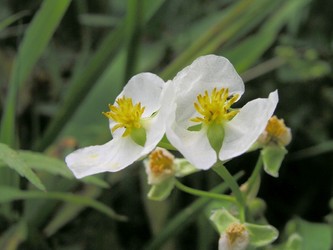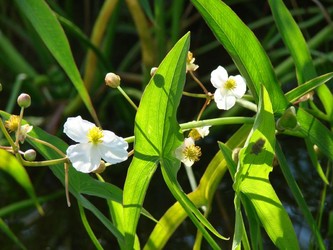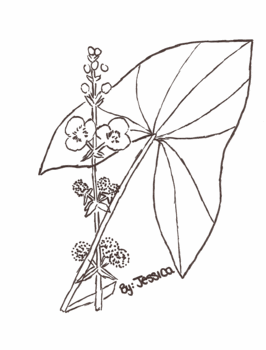Lakota Name: hiηhaή tahaήpe (means “owl’s moccasin” name refers also to an appendix to the buffalo’s heart, arrow-head shaped as are the leaves of this plant)
 Listen to Lakota Plant Name: hiηhaή tahaήpe
Listen to Lakota Plant Name: hiηhaή tahaήpe
Medical Uses: A poultice of the leaves has been used to stop milk production. A poultice of the roots is used in the treatment of wounds and sores.
Similar plants: Alisma app., Valisneria sp., Sparganium spp.
Chemical compounds: Terpenoids- Plant terpenoids are used extensively for their aromatic qualities. They play a role in traditional herbal remedies and are under investigation for antibacterial, and other pharmaceutical functions.


Molecular structure of a terpenoid © 1sagebrush2.
Importance of plant: Tubers were an important food source for Native Americans. Tubers also provide food for beavers and muskrats. Tubers and achenes provide food for waterfowl.
Edible Uses: Root raw or cooked, excellent when roasted, the texture is somewhat like potatoes with a taste like sweet chestnuts. The tubers can be eaten raw but they are rather bitter (especially the skin). It is best to remove this skin after the tubers have been cooked. The tubers can also be dried and ground into a powder. This powder can be used as gruel or mixed with cereal flours and used to make bread. The N. American Indians would slice the boiled roots into thin sections and then string them on ropes to dry in much the same way as apples. The egg-shaped tubers are 4-5 cm long and are borne on the ends of slender roots, often 30 cm deep in the soil and some distance from the parent plant. The tubers are best harvested in the late summer as the leaves die down. They cannot be harvested by pulling out the plant since the tops break off easily, leaving the tubers in the ground.



Sagittaria latifolia. Left: male flowers © 2006 Per Verdonk. Right: leaves and male flowers © 2006 Scott Young.
Description: Broadleaf arrowhead is a variable-sized (0.2 to 1 m) perennial growing in colonies that can cover large amounts of ground. The roots are white and thin, producing white tubers covered with a purplish skin a good distance (0.3 to 1 m long, 0.15 to 0.6 meter deep) from the mother plant. The plant has no stem to speak of, producing a rosette of leaves and an inflorescence on a long rigid hamp. The leaves are extremely variable, from very thin at 1 to 2 cm to wedge shaped like those of Sagittaria cuneata. Spongious and solid, the leaves have parallel venation. The inflorescence is a raceme composed of large flowers whorled by threes. Usually divided into female flowers on the lower part and male on the upper, although different sexes individuals are also found. Three round, white petals and three very short curved, dark green sepals. Male flowers are easily distinguished from female due to the dissimilarity between the 25 to 50 yellow stamens of the male and the sphere of green carpels of the female ones. Shubenacadie, a community located in central Nova Scotia, Canada, means "abounding in ground nuts" (i.e., broadleaf arrowhead) in the Micmac language.
South Dakota Distribution: S. latifolia is the most common species of Sagittaria in marshes and on shores over the state.- S. latifolia is located in about 1/3 of the South Dakota counties in the USDA database.
Habitat: Ditches, ponds, lakes, swampy areas in most parts of N. America, Shore lines and marshy areas
Global Distribution: Widespread across North America, but also found natively in Hawaii, the Caribbean and the northern part of South America, broadleaf arrowhead has been introduced in Europe and Australia, where it is considered an invasive weed. The plant is considered rare in Alberta. It can be found frequently in the Fraser Valley region of British Columbia.
Existing or Potential Threats: NONE




 Go to quick links
Go to quick search
Go to navigation for this section of the ToL site
Go to detailed links for the ToL site
Go to quick links
Go to quick search
Go to navigation for this section of the ToL site
Go to detailed links for the ToL site